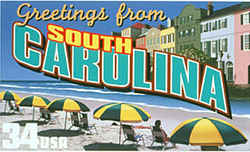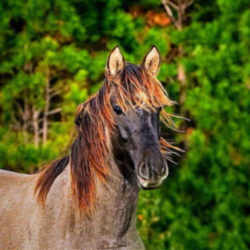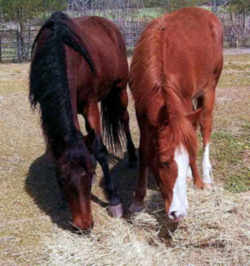
South Carolina Symbols
South Carolina State Heritage Horse
Marsh Tacky

(E. f. caballus )
Adopted on June 11, 2010
The Marsh Tacky was designated as the official State Heritage Horse by Act Number 240 of 2010. The Marsh Tacky is a rare colonial Spanish horse breed unique to South Carolina. These tough horses have played a pivotal role in the development and defense of South Carolina and were an intergral part of life in early Lowcountry communities, providing transportation and agricultural horsepower. The Carolina Marsh Tacky Assocation was established in 2007 to preserve and promote the Marsh Tacky Horse. Visit the Carolina Marsh Tacky Association website to learn more about the history and the future of this rare breed.
The marsh tacky became South Carolina's official state heritage horse when Governor Mark Sanford signed Senate Bill No. 1030 on June 11, 2010.
The Carolina Marsh Tacky Association was jubilant!
After a long 5 years, the Marsh Tacky has become the official State Heritage Horse of South Carolina! The Governor's signature on June 11, 2010 gave
formal recognition to an important part of South Carolina's living history. This horse forged the southern wilderness, survived while others perished,
carried our ancestors through war, sustained countless families, and managed to hang on despite the invasion of tractors, automobiles, bridges, and
urban sprawl.
Thank you to all who have supported this bill and to the members of our state legislature who recognized this hearty, spirited, little horse as an
important part of our heritage.
Jackie McFadden
CMTA State Horse Committee
South Carolina State Heritage Horse: Marsh Tacky

The Carolina Marsh Tacky or Marsh Tacky is a rare breed of horse, native to South Carolina. It is a member of the Colonial Spanish group of horse breeds, which also include the Florida Cracker Horse and the Banker horse of North Carolina. It is a small horse, well adapted for use in the lowland swamps of its native South Carolina. The Marsh Tacky developed from Spanish horses brought to the South Carolina coast by Spanish explorers, settlers and traders as early as the 16th century. The horses were used by the colonists during the American Revolution, and by South Carolinians for farm work, herding cattle and hunting throughout the breed's history.
The breed is considered to be critically endangered by both the American Livestock Breeds Conservancy and the Equus Survival Trust, and there are only around 275 Marsh Tackies in existence today. In 2006 and 2007, the two organizations worked together to complete DNA testing on the breed with the goals of mapping the Marsh Tacky's place among the horse breeds of the world and beginning a stud book. In 2007, an association was begun with the objective of preserving and promoting the Marsh Tacky; and in 2010 a closed stud book was created.
The Marsh Tacky is sturdy and balanced and stands around 14 hands. The Lowcounty superbly shaped this relatively small horse and in turn created a breed capable of the work and strength normally found in much larger horses. The Marsh Tacky is muscular and "an easy keeping horse with a sharp mind."Most Marsh Tackies are roans, bays, and solid in color. At first glace, the Marsh Tacky may look like an ordinary horse. Its abilities astound many.
Different horses have different gaits or ways of moving. A horse that has special ways of moving is said to be gaited, like the Tennessee Walking horse, which is known for its smooth gait. After many stories noting the extreme comfort and unusual smoothness of the Marsh Tacky, people wondered if the Marsh Tacky was a gaited horse. A recent scientific study was undertaken through the Gaited Locomotive Research Program at Mississippi State University and American Livestock Breeds Conservancy. It concluded that the Marsh Tacky is indeed a gaited breed. The Marsh Tackies movement has been studied quite closely and it has been determined that the gait itself is like no other in the world, other than a slight similarity to the Marchador of Brazil. This gait will eventually be named and unique to the Marsh Tacky.
Marsh Tacky Breed Standard
Temperament
- Temperament is one of the most important aspects of a Marsh Tacky - alert but calm, levelheaded, and not prone to panic
- Must be sure-footed in wooded and swampy lands
- Have the ability to calmly and effectively get out of boggy areas safely and quickly
General appearance and function
- Balanced and athletic
- Known for being "easy keepers" on forages with little supplemental feeding
- Most have a fluid, smooth trot
- Some are gaited
Height
- Usual height is from 14 hands to 14.2 hands high at the withers
- Usual range in height is from 13 hands to 15 hands
Head
- Profile of the head is usually flat or slightly concave, but becomes slightly convex from the nasal region to the top of the muzzleb
- From the front view, the head is wide between the eyes, then tapers and is finely"chiseled" or defined through the mid region, then flares back out at the region of the nostrils and tapers to a fine muzzle
- Nostrils are fine and crescent-shaped at rest. They flare larger and more open when excited or under exertion
- Ears are short to medium length, and most have a distinctive inward pointing notch at the tips
- Eyes are usually large, bold and high on the head though smaller eyes are acceptable
- Profile of the muzzle (from the side) is refined, with the top lip usually longer than the bottom lip
Neck
- Neck is wide from the side, though it is still typical to have a slight ewe-neck
- Neck is attached lower on the chest than most other breeds
Withers
- Withers are pronounced and obvious, or even "sharp"
Back
- Back is short and strong
Rear
- Conformation is angled from the top of the croup to the tail base, usually a 30 degree slope, some are steeper
- Tail is set low, so that it appears to "fall off" the croup smoothly
- Rear end has a distinct break at the point of the hip, the line from the top of croup to point of hip is one line or curve, then it breaks and continues as a different curve from the point of the hip to the back of the gaskin
- From the rear view, the spine is usually the top of the rear, and the muscles taper down off of this (rafter-hipped)
- From the side the hips should be long and well angled, rather than steep and short
Front
- From the side, the chest is deep and usually accounts for about half the height of the horse
- From the front, the chest is narrow and the legs usually point up to an "A" shape at the chest.
- Shoulder is long and has a 45to 55 degree angle
- From the front view, the limbs should fall straight from the shoulder to the ground
Rear Limbs
- From the rear view, the rear limbs are usually straight or slightly inward at the hocks, then straight to the ground.
- Legs are very flexible, and at the trot the hind track can land past the front track
- Muscling is long and tapering
- Usually no feathering on the fetlocks
- Feet are balanced, and of a size to fit the overall weight of the horse
- Hooves are tough and wear well
Chestnuts
- Chestnuts are usually small and nearly nonexistent, to larger and more obvious. The most typical are small and flat. Some horses lack rear chestnuts entirely
Color
- Any color is permissible, but some colors are more common
- Most common colors include bay,black, grullo, dun, blue roan, and bay roan
- Chestnut, red dun, and strawberry roan are also common
- Many horses have little or nowhite markings on them, some have extensive white on the legs and heads
South Carolina Senate Bill No. 1030.
A BILL
TO AMEND THE CODE OF LAWS OF SOUTH CAROLINA, 1976, BY ADDING SECTION 1-1-714 SO AS TO DESIGNATE THE MARSH TACKY AS THE OFFICIAL STATE HERITAGE HORSE
OF SOUTH CAROLINA.
Amend Title To Conform
Be it enacted by the General Assembly of the State of South Carolina:
SECTION 1. The General Assembly finds:
(1) The Marsh Tacky, a rare colonial Spanish horse breed unique to South Carolina, has played a significant role in South Carolina's history. After
abandonment by the Spanish on the South Carolina Sea Islands and along the South Carolina coast some five hundred years ago, the Marsh Tacky survived
on its own and developed into a unique strain of colonial Spanish horse. These tough, little horses assisted our forefathers in the development and
defense of our State and were the major source of transportation in the Lowcountry before the introduction of the automobile. Marsh Tackies were important
to the Gullah community and became an integral part of agricultural life for Lowcountry families. Marsh Tackies were used wherever horsepower was needed;
to pull plows and wagons, herd cattle, hunt wild game, deliver the mail, transport families, and as loyal, sturdy war mounts. Most Lowcountry families
had Marsh Tackies in their fields or gardens.
(2) During the American Revolution, Marsh Tackies assisted in the victories of the famous 'Swamp Fox' General Francis Marion, whose troops of 'Irregulars'
had the advantage of being mounted on small, agile horses that were superbly adapted to the Lowcountry's rough, swampy terrain. Marsh Tackies required
little care from the troops, were able to travel long distances without fatigue, and survived on forage, reducing the need for supply wagons carrying
grain. The sure-footed Marsh Tacky enabled the militia to out maneuver the British troops who rode larger European horse breeds that could not traverse
the swampy forests.
(3) Marsh Tackies served the southern Confederate cavalry during the Civil War. Unlike northern troops who were issued horses, southern recruits were
often required to provide their own mounts, which were trained and familiar with their riders, giving an early advantage to the southern forces.
(4) In World War II, Marsh Tackies were used by the Coast Guard's Mounted Beach Patrol to protect our mainland from enemy spies and saboteurs. The
'Beach Pounders' who patrolled the southeastern shore were trained at the Mounted Beach Patrol and Dog Training Center in Hilton Head, South Carolina,
and patrolled the coast from Florida to North Carolina.
(5) Marsh Tackies have little changed since the colonial period. Relative isolation on the Sea Islands and secluded areas of the Lowcountry, along
with owner dedication to the preservation of the breed, has allowed the Marsh Tacky to remain relatively untouched. Owners often comment on the built-in
'woods sense' of the breed and how the horses have a natural way of traversing water obstacles and swamps. Many horses display characteristics and
primitive markings carried by their Spanish ancestors including dorsal stripes, zebra leg stripes, and lengthy manes and tails.
(6) In 2007, Marsh Tacky owners and enthusiasts across the State formed the Carolina Marsh Tacky Association to preserve and promote the history and
heritage of the Marsh Tacky horse. The association works closely with the American Livestock Breeds Conservancy to provide ongoing registry, stud book,
and breeding program to ensure the survival of the Marsh Tacky.
(7) With its rich heritage, resilience, and perseverance, the Marsh Tacky embodies the very spirit of South Carolina. The Marsh Tacky is uniquely of
South Carolina and remains a living piece of history in its native State, a claim that no other breed can make. The Marsh Tacky has earned the title
of State Heritage Horse of South Carolina.
SECTION 2. Chapter 1, Title 1 of the 1976 Code is amended by adding:
"Section 1-1-714. The Marsh Tacky is designated as the official State Heritage Horse of South Carolina."
SECTION 3. Chapter 1, Title 1 of the 1976 Code is amended by adding:
"Section 1-1-714A. The mule is hereby designated as the official State Heritage Work Animal of South Carolina."
SECTION 4. This act takes effect upon approval by the Governor.
----XX----
South Carolina Law
The law designating the Marsh Tacky as the official South Carolina state horse is found in the South Carolina Code of Laws, Title 1, Chapter 1, Article 9, Section 1-1-714.
Title 1 - Administration of the Government
CHAPTER 1. GENERAL PROVISIONS
ARTICLE 9. STATE EMBLEMS, PLEDGE TO STATE FLAG, OFFICIAL OBSERVANCES
SECTION 1-1-714. Official state heritage horse.
The Marsh Tacky is designated as the official State Heritage Horse of South Carolina.
HISTORY: 2010 Act No. 240, Section 2, eff June 11, 2010.
Taxonomic Hierarchy: Marsh Tacky
Kingdom: Animalia
Phylum: Chordata
Class: Mammalia
Order: Perissodactyla
Family: Equidae
Genus: Equus
Species: E. ferus
Subspecies: E. f. caballus







